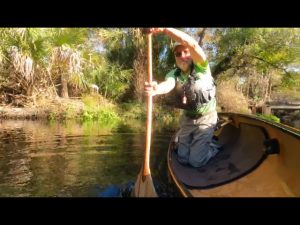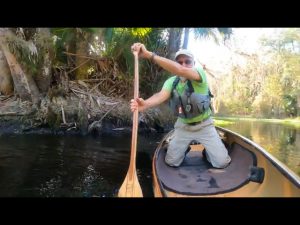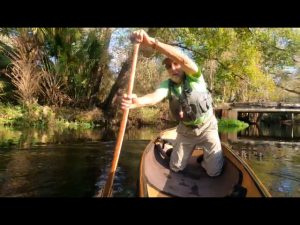By Marc Ornstein
Often, after one concludes a maneuver (a turn) little thought is given about what the paddle needs to do next. Will you be continuing forward, on your journey, going directly into another maneuver or have you reached your destination? In the vast majority of cases, you’ll be continuing on your journey and your next paddle placement will be the catch, for a forward stroke.
If you are traveling forward, almost any maneuver concludes with the paddle up forward, near the bow. An axle or a post conclude with a draw to the bow. A Christie, with a reverse sweep to the bow. Even a wedge, when used in most functional situations ends with the paddle still at the bow, the concluding sweep rarely being necessary. When observing other paddlers, I invariably see them conclude and then slice the paddle out or back to their usual catch placement, just ahead of their knee.
The most effective catch is as far forward as can reasonably be reached without undue bending at the waist and bobbing of the canoe. The farther forward the catch, the less yaw (turning of the canoe toward the offside) that is induced. A far forward catch also allows for a longer power phase of the forward stroke. With that in mind why would one bring the blade back from the bow to the knee for the 1st catch after a maneuver, squandering what would have been the most effective portion of the stroke?
The obvious answer, and the one most often presented to me, is that with the blade so close to the bow one can’t reach far enough forward for a proper, vertical paddle placement is not possible if the catch is much beyond the knee. That’s correct if the paddler is in a standard three-point stance but there is a solution. One that allows for both a far forward placement and a vertical paddle at the catch.
At the conclusion of whatever maneuver preceded the forward stroke, the paddler is likely leaning forward and up (partially or fully) on both knees. If not fully erect (vertical torso), on both knees, he or she should gently rise to that position. From that stance one can comfortably raise the grip/paddle for a perfect, vertical, far forward catch. In other words, don’t bring the paddle back to you; bring yourself up to the paddle. (Note: The paddler should be careful not to weight the onside knee as that will induce heel causing the canoe to carve toward the offside. That carve could be significant since the forward body position has pitched the bow down and freed the stern.)

Now to take full advantage of this far forward, body/blade position. With firm but gentle hands on the grip and shaft, arms nearly straight, the paddler drops back to a three-point stance, using his or her full body weight to gently bring the paddle along then smoothly completes the stroke along with any correction needed. An added benefit is that from a two point kneel, drawing against the paddle as you settle back onto the seat eases the strain on your leg and other muscles.
 |
 |
You may see a short Youtube video demonstrating using this link:
Up until now, this discussion has been limited to forward maneuvers, but it needn’t be. Cross maneuvers are often followed by a cross forward stroke or two before switching back to the onside. Cross forwards should always be placed far forward, making this technique a perfect fit. In reverse the benefits may be less apparent but if the maneuver is to be followed by a far back or compound reverse stroke, a far sternward catch is just as useful. In cross reverse, simply visualize the stern as you would the bow when traveling forward.
A key element of advanced paddling is planning ahead. take advantage of opportunities to utilize the canoe’s momentum, the paddle’s placement and your own body position.